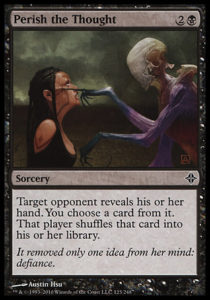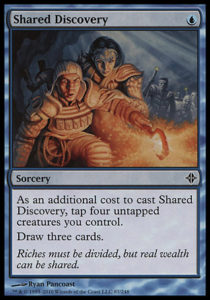I ask many players what their favorite Limited format is (it’s a go-to conversation topic). If folks have been playing for a while, Rise of the Eldrazi is usually in the top three and often first. I wasn’t around for it when it was out, but I’ve logged at least twenty or thirty Rise drafts. And you know what? I don’t love it.
*Gasp*
“Blasphemy!”
“He learned to draft on Scars block! What does he know?!”
“The Eldrazi spawn! Won’t somebody think of the Eldrazi spawn?!”
Strong reactions, with perhaps just a slight (re:generous) application of dramatization. In all seriousness, I usually receive shocked reactions when I tell folks that I don’t love Rise. There are plenty of reasons to love the format, after all:
The mechanics are sweet! Level up allows any serviceable low drops to become a game-ending threat, plus it piggybacks on all the fun of having your own RPG character. Rebound is an all-upside mechanic that produces gems like Staggershock. Totem Armor mitigates most of the card disadvantage of auras and is perhaps the first aura mechanic to be really, really exciting. Eldrazi spawn allow ramp (one of my favorite things in magic) to be played by any color deck, not only green ones. Annihilator is an epic mechanic that ends games and makes you feel like you’re really in control of a power capable of destroying the fabric of reality itself.
There are plenty of archetypes! There’s the classic RG ramp or WU levellers. There’s Jund tokens with Raid Bombardment. There’s Gx Aura Gnarlid. There’s UR Sphinx-Bone Wand with Distortion Strike and Kiln Fiend/Surrakar Spellblade. There’s BR control and BR sacrifice. There’s R/x defenders with Vent Sentinel. There’s Shared Discovery.deck. There’s invoker ramp and Broodwarden tokens. Half of these decks are trying to routinely cast Ulamog’s Crusher on or below curve. There’s a wealth of options to choose from.
What gives? I love the mechanics and I love a format with plenty of archetypes to go into. I love ramping and resolving eight drops. I love Prophetic Prism. Why don’t I love Rise draft? Sure, I certainly like it, but it doesn’t evoke the love I have for Innistrad, Modern Masters, and Ravnica: City of Guilds Limited.
I’ve been conducting research (re: drafting lots of Rise on MODO) all week long and I think I’ve made a few discoveries—not only on what I enjoy, but also on what I believe makes for a good Limited format.
1. Garbage Commons
There are a whole slew of unplayable-to-bad commons. Often by the third pick there’d be nothing in the pack except for a Distortion Strike for the UR player, an Eland Umbra for an auras player, and a Brood Birthing for a dedicated tokens deck.
I prefer formats like Innistrad, MMA, or Theros, where most commons have a home in one deck or another and very few are unplayable or playable only in a single, very specific deck. I believe that one of the biggest failures of Avacyn Restored Limited (aside from the dearth of removal) was the plethora of garbage commons. Without sufficient options or flexibile in draft picks, every deck in AVR felt the same. Which brings me to my second point.
2. Redundant Archetypes
While I love ramp, perhaps half of all archetypes in Rise draft follow the same formula: produce lots of mana, then resolve a game-winning threat. Ramping into Artisan of Kozilek with Overgrown Battlement and Emrakul’s Hatcher is quite similar to using Venerated Teacher to produce tons of mana for level up creatures. Raid Bombardment uses the same means (Eldrazi spawn) to power out a different win condition. This method is consistent across a variety of archetypes (though levelers uses its ramp after deploying its threats). Even though the win conditions are starkly different, the majority of a game of Magic is spent building up to the win condition (the method) while a minority is spent winning it. Accordingly, I find many drafts, despite different color choices and archetypes, to be playing out similarly.
This leads back into my first point: the dearth of good commons. When many/most decks are trying to do the same thing, they value the same cards. Nest Invader, Ondu Giant, Kozilek’s Predator, Overgrown Battlement and Wildheart Invoker are good in all green decks. (The only green deck that doesn’t need them as much is Aura Gnarlid, however Aura Gnarlid fits neatly into most green decks.) When all green decks are doing the same thing and valuing the cards highly, cards are picked clean of the few good cards rapidly (and because it’s a large set, there’s plenty of chaff in each pack). When the “niche” decks like Raid Bombardment are fighting with the “primary” decks like Eldrazi ramp for almost all the same cards, and only benefit from a few reward cards (Might of the Masses, Bloodthrone Vampire, Brood Birthing), it can be hard to pick up the necessary playables or have different archetypes feel distinct.
3. Thin Archetypes
There are archetypes that eschew ramping and tokens. These are decks like Gx auras, UR spells, defenders, and BR control. I’ve drafted them all and they’re very fun. However, they each essentially rely on a single common to function: Aura Gnarlid, Kiln Fiend, and Vent Sentinel. If these cards aren’t opened (in multiples), then even if the archetypes are wide open, the decks won’t function. It may be a triple set draft format, but it’s a large set and there’s no guarantee that there’ll be enough copies of these critical commons to go around. These archetypes do distinguish themselves from the majority ramp decks, but are fragile in relying heavily on a single card. BR control is the exception in that it can function with a variety of cards, however it relies on drafting multiple copies of the top black and red commons (Staggershock, Vendetta, Induce Despair, Heat Ray, and Last Kiss) and accordingly fights with every other black or red drafter at the table.
I don’t mind the existence or fragility of niche decks: I’m happy that Spider Spawning exists, for example, just as I like playing with Kiln Fiend. I acknowledge that these decks can function without a single copy of their namesake card (though it’s much harder for them to win) and that that’s fine for an archetype. My complaint is that the only alternative to drafting some kind of ramp deck is to draft an all-in niche deck. I believe that I’d enjoy the format more/it’d be a superior format if these alternative archetypes were deeper and didn’t involve betting it all on acquiring multiple copies of a specific common.
I’m sorry if I spoke ill of your beloved format. I do enjoy drafting Rise, though it’s not among my favorite Limited formats. I believe that Limited environments that support a variety of archetypes, with a variety of game plans, and a dynamic pick order that depends on one’s decks, are superior. I believe that a flatter power level, with more playable commons at the bottom and fewer universally amazing commons at the top, produces a more enjoyable experience. I also believe that I could be wrong about Rise—that its archetypes are deeper than I suggested, its pick orders more dynamic than I’ve been led to believe, and that its weaker commons are better than I’ve stated. So, I’d like to know what you think. Do you love Rise? If so, why? Do you find my arguments compelling, fallacious, boring, or in need of work? Please, feel free to e-mail me or post in the comments. I invite your discussion as I further question what makes for a good Limited format. And, as always, thanks for reading.
—Zachary Barash
twitch.tv/ZennithGP — Join the livestream!
Magic Online username: Zennith
Zachary Barash has been playing Magic on and off since 1994. He loves Limited and drafts every available format (including several that aren’t entirely meant to be drafted). He’s a proud Cube owner and performer, improvising entire musicals every week with his team, Petting Zoo. Zach has an obsession with Indian food that borders on being unhealthy.



